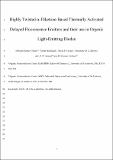Highly twisted α-diketone-based thermally activated delayed fluorescence emitters and their use in organic light-emitting diodes
Date
23/09/2021Author
Grant ID
N/A
NF171163
EP/P010482/1
ep/l017008/1
Metadata
Show full item recordAbstract
We have designed a highly twisted small TADF emitter PXZ-α-DK based on an a-diketone (α-DK) as a strong acceptor and phenoxazine (PXZ) as a strong donor to obtain red-shifted emission in comparison to the equivalent a-diketone linked to 9,9-dimethyl-9,10-dihydroacridine (DMAC). The PXZ-α-DK shows emission at 586 nm and DMAC-α-DK shows emission at 548 nm in 1,3-bis(N-carbazolyl)benzene (mCP) host at 1.5 wt% doping of the emitter, with short-delayed lifetimes of 6.9 μs for PXZ-α-DK and 7.6 μs for DMAC-α-DK. OLEDs fabricated using these emitters show green electroluminescence at 555 nm for DMAC-α-DK, with a maximum external quantum efficiency, EQEmax, of 6.3%, and orange electroluminescence at 585 nm for PXZ-α-DK, with an EQEmax of 0.8%. We corroborate the optoelectronic properties of these emitters with DFT calculations.
Citation
Gupta , A K , Matulaitis , T , Cordes , D B , Slawin , A M Z , Samuel , I D W & Zysman-Colman , E 2021 , ' Highly twisted α-diketone-based thermally activated delayed fluorescence emitters and their use in organic light-emitting diodes ' , Canadian Journal of Chemistry , vol. Early View . https://doi.org/10.1139/cjc-2021-0208
Publication
Canadian Journal of Chemistry
Status
Peer reviewed
ISSN
0008-4042Type
Journal article
Description
AKG is grateful to the Royal Society for Newton International Fellowship NF171163. We acknowledge support from the Engineering and Physical Sciences Research Council of the UK (grants EP/P010482/1 and EP/L017008/1). We are also grateful for financial support from the University of St Andrews Restarting Research and Restarting Interdisciplinary Research Funding Schemes (SARRF and SARIRF) which are funded through the Scottish Funding Council grant reference SFC/AN/08/020.Collections
Items in the St Andrews Research Repository are protected by copyright, with all rights reserved, unless otherwise indicated.

